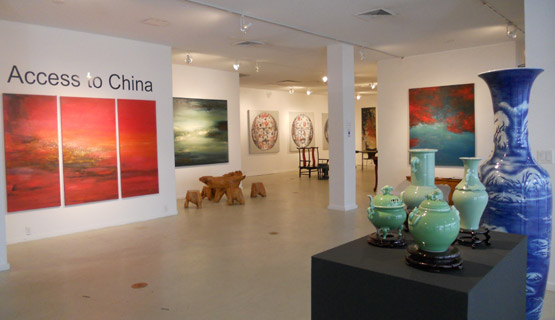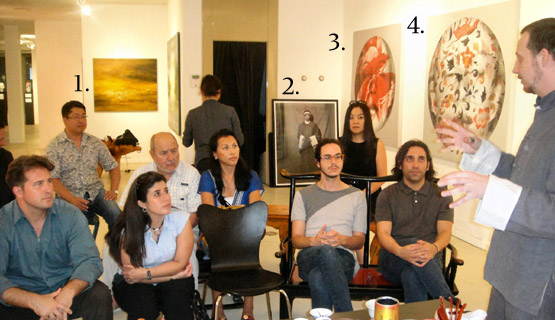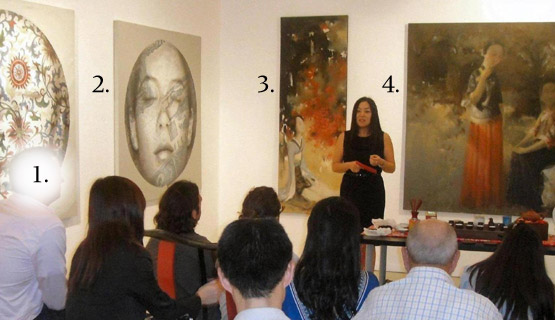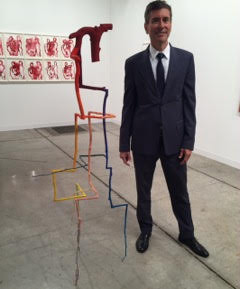Art Miami
Tony Japour Gives Us “Access to China”


Anthony Japour (AJ) is an independent curator, private art dealer and owner of AJ Japour Gallery. The gallery deals in contemporary art with a focus on the Chinese Contemporary Art Movement and its relationship to the pillars of Western Contemporary Art. Since 2003, AJ has produced numerous art exhibitions and installations in Miami and South Florida. In addition, the Gallery’s secondary mission is to support organizations dedicated to the health, education, and welfare of children. AJ has served on the Fine Arts Board and the Cultural Arts Council of the City of Miami Beach.
Preamble
What did President Richard Nixon and Andy Warhol know that the rest of us missed back in 1971-72? Being only 12 years old, I think I deserve a pass – but what about everyone else?
The answer lies in two historic images. One of President Nixon shaking hands with Mao Tse-Tung and the other is from a series of Warhol’s Mao paintings. Namely, that United States of America had to make a serious effort to engage the world’s most populated country. And by engaging China, despite its communist ways, the relationship helped in the following decade to end Soviet totalitarianism and dissolve the Soviet Union.
So what is it that some recognize in Chinese Contemporary Art that the rest of Miami is missing? The answer: with over 5000 years of continuous civilization combined with the tumultuous past 50 years, China’s contemporary art production is destined to play a major role in the history of the art of our time.
For those who think Chinese art is a fad, you are wrong. This year China surpassed the United States, Great Britain, and France to become the #1 art market in the world. For those who think it is too market oriented and is all about prices, wrong again. Whatever you think about the subject matter, the concept and rendering of many of the important Chinese contemporary artists’ works are superior to much of the art production around the world.
Continued below…

Access to China
A three-part exhibition sponsored by International Chinese Fine Arts Council, Art Lexing and the Miami Design District
Buena Vista Building Space 120
180 NE 39th Street
Miami, FL 33137
www.icfac.org
The Feminine Flair, curated by Lexing Zhang
Displaying the work of Ye Hongxing, Wang Xiaojin and Art Lexing
Emerging Art on Paper, curated by Inez Suen
Recent graduates from the China Academy of Art in Hangzhou
Chinese Iconography on Porcelain
Frank Tse Collection
A young not-for-profit organization, known as the International Chinese Fine Arts Council, established in Chicago, founded an outpost in Miami last year with Director, Inez Suen at its helm. A native of Chicago by way of Taipei, Taiwan, Suen moved to Miami in 2010 from New York City because of Miami’s connection to Art Basel-Miami Beach and the dearth of Asian art in Miami. ICFAC exhibited both crafts and fine art from Taiwan in Miami during Art Basel 2010, and has a new exhibition in partnership with Art Lexing through the end of May entitled, “Access to China”.
There are many factors contributing to the explosion of Chinese contemporary art onto the international contemporary art scene since 2006-2007. Among them include the tremendous social and economic changes (though not political) since the end of Mao Tse-Tung’s “Cultural Revolution” (1966-76); the international recognition of Chinese Contemporary artists; the economic success of the Chinese economy and the growing number of wealthy Chinese; focus on Chinese Contemporary art by auction houses; support of the Chinese government in organizing exhibitions and permitting freedom of artistic expression (although artist Ai Wei Wei’s recent arrest and disappearance being a sign that there are limits to this freedom); and adoption of cultural patrimony laws restricting the exportation of Chinese antiquities.
The curated exhibition by Suen and Zhang has a distinctive feminine sensibility with the combination of porcelain iconography along with paintings by two young emerging artists, one woman and one man, both of whom paint women.
Continued below…

Ye Hongxing uses traditional Chinese motifs along with traditional Chinese porcelain decorative patterns in her paintings which very much complement the Frank Tse Porcelain Collection. All of Hongxing’s paintings on view are “self-portraits” where the artist’s face blends into the background of the decorative motif. This “blending” into the background is a recurrent theme in the Chinese Contemporary Art movement serving perhaps as a metaphor for the individual’s need to blend into the larger population in an authoritarian government. If government officials don’t pick you out of a crowd, they’re less likely to give you trouble. In several of the works on view, one has to look hard to see the image of the artist’s face covertly painted onto the canvas.
The works by Wang Xiaojin remind me of how much the Chinese, and in particular, even the young artists today, respect tradition in Chinese society. This sensibility contrasts with a common American view, one expressed by one of our forefathers Thomas Jefferson, which espouses the belief the earth belongs to the living.
Continued below…

America, while respecting the past, is a culture which is constantly pushing boundaries and forging new ground; this cultural tradition is perhaps reflective of our artistic output which seems to continually be stretching “out of the box” thinking. Nevertheless, as noted in Xiaojin’s artist statement, he is inspired by the distant past in which ornate porcelain vases, with elaborate flower arrangements, embroidered silk dresses, modish furniture serve to create the opulent world in which being “feminine” typified a woman’s existence.
However, this work provides a cautionary note to this generation of ambitious young artists. Namely, that the international contemporary art world is just that, “international”. Those who wish to be the next Picasso will need to find a visual language that is innovative rather than derivative. The successful Chinese contemporary artists will be those who have not only considered the past but those who think beyond the past and into the present and future. Likewise, American artists, and those with a western orientation, need to recognize that there are limits to what art connoisseurs will accept as art. It is not those sitting in the auction rooms today who will decide, but those of successive generations. They will be the arbitrars of what is considered the important art of our time.

Anthony Japour is an art collector and art advisor. Japour lectures on the Chinese Contemporary Art Movement and its relationship to the pillars of Western Contemporary Art. For over a decade [2002-2012], Japour mounted numerous art exhibitions and installations in Miami Beach and South Florida through AJ Japour Gallery and linked these exhibitions to charity events at his home in South Beach devoted to the health, education and welfare of children. Japour has served on the Fine Arts Board and the Cultural Arts Council of the City of Miami Beach. Japour has been a contributor writing on contemporary art for SocialMiami.com since 2010.


